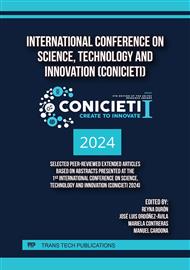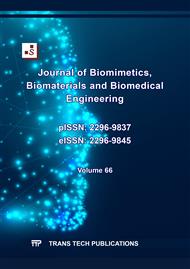[1]
M. Kuliha y S. Verma, «Secure internet of medical things based electronic health records scheme in trust decentralized loop federated learning consensus blockchain», International Journal of Intelligent Networks, mar. 2024.
DOI: 10.1016/j.ijin.2024.03.001
Google Scholar
[2]
B. Coutinho, J. Ferreira, I. Yevseyeva, y V. Basto-Fernandes, «Integrated cybersecurity methodology and supporting tools for healthcare operational information systems», Computers & Security, vol. 129, p.103189, jun. 2023.
DOI: 10.1016/j.cose.2023.103189
Google Scholar
[3]
International Telecommunication Union (ITU), Global Cybersecurity Index 2020, 4.a ed. Geneva, Switzerland, 2021.
Google Scholar
[4]
Asamblea Nacional Constituyente, CONSTITUCIÓN POLÍTICA DE 1982, ene. 1982, p.17.
Google Scholar
[5]
Código Penal De Honduras Decreto No.130-2017, 25 de enero 2021. Republica de Honduras: OIM S.A. de C.V., 2019, pp.186-189.
Google Scholar
[6]
INSTITUTO DE ACCESO A LA INFORMACION PÚBLICA, «Ley de Transparencia y Acceso a la Informacion Publica», Tegucigalpa, M.D.C., dic. 2006.
DOI: 10.3145/epi.2012.sep.09
Google Scholar
[7]
Poder Judicial de Honduras, «LEY ESPECIAL SOBRE VIH/SIDA», Corte Suprema de Justicia, Tegucigalpa, M.D.C., sep. 1999.
Google Scholar
[8]
Colegio Medico de Honduras, «CÓDIGO DE ÉTICA DEL COLEGIO MEDICO DE HONDURAS », Colegio Médico de Honduras, Tegucigalpa M.D.C., 2006.
DOI: 10.36576/summa.29160
Google Scholar
[9]
Banco Interamericano de Desarroll, «Reporte-Ciberseguridad-2020-riesgos-avances-y-elcamino- a-seguir-en-America-Latina-y-el-Caribe.pdf». 2020. [En línea]. Disponible en: www.observatoriociberseguridad.com
DOI: 10.18235/0002513
Google Scholar
[10]
INSTITUTO DE ACCESO A LA INFORMACION PÚBLICA, «Anteproyecto de Ley de Proteccion de Datos Personales y Accion de Habeas Data de Honduras Final», Instituto de Acceso a la información Pública, Tegucigalpa M.D.C., 2014. Accedido: 22 de mayo de 2023. [En línea].
DOI: 10.2307/jj.16192242.6
Google Scholar
[11]
Unidad Reguladora y de Control de Datos Personales, «LOS DATOS PERSONALES Y SU PROTECCIÓN URUGUAY». 24 de enero de 2022. Accedido: 14 de junio de 2023. [En línea].
DOI: 10.2307/j.ctv1tqcx2c.7
Google Scholar
[12]
Comisión Nacional de Bioética,Secretaria deSalud de Mexico, «Proteccion datos personales salud Mexico». marzo de 2014. [En línea].
Google Scholar
[13]
C. S. Kruse, B. Frederick, T. Jacobson, y D. K. Monticone, «Cybersecurity in healthcare: A systematic review of modern threats and trends», THC, vol. 25, n.º 1, pp.1-10, feb. 2017.
DOI: 10.3233/THC-161263
Google Scholar
[14]
S. G. Langer, «Cyber-Security Issues in Healthcare Information Technology», J Digit Imaging, vol. 30, n.o 1, pp.117-125, feb. 2017.
DOI: 10.1007/s10278-016-9913-x
Google Scholar
[15]
A. Fraile Hernández, «Ciberseguridad: clave en el sector sanitario», I+S: Revista de la Sociedad Española de Informática y Salud, n.º 139, pp.32-33, 2020.
Google Scholar
[16]
Consejo Europeo, «Convenio de Sobre la Ciberdelincuencia». 2001. Accedido: 8 de mayo de 2023. [En línea]. Disponible en: https://www.oas.org/juridico/english/cyb_pry_ convenio.pdf
Google Scholar
[17]
División de Ciberdelincuencia, «Adhesión al Convenio sobre la Ciberdelincuencia: Beneficios ». 04 de 2023. [En línea]. Disponible en: https://rm.coe.int/cyber-buda-benefits-junio2022- es-final/1680a6f9f4
Google Scholar
[18]
F. A. Martins, M. S. Ruiz, S. F. de P. Monken, L. Ferreira da Silva, y E. Del Rosario Santibanez Gonzalez, «Risk management focusing on the best practices of data security systems for healthcare », International Journal of Innovation: IJI Journal, vol. 9, n.o 1 (Jan./Apr.), pp.45-78, 2021.
DOI: 10.5585/iji.v9i1.18246
Google Scholar
[19]
S. Ghafur, E. Grass, N. R. Jennings, y A. Darzi, «The challenges of cybersecurity in health care: the UK National Health Service as a case study», The Lancet Digital Health, vol. 1, n.o 1, pp. e10-e12, may 2019.
DOI: 10.1016/S2589-7500(19)30005-6
Google Scholar
[20]
H. S. Lallie et al., «Cyber security in the age of COVID-19: A timeline and analysis of cybercrime and cyber-attacks during the pandemic», Computers & Security, vol. 105, p.102248, jun. 2021.
DOI: 10.1016/j.cose.2021.102248
Google Scholar
[21]
European Union Agency for Law Enforcement Cooperation, «Pandemic profiteering: how criminals exploit the COVID-19 crisis». 27 de marzo de 2020. Accedido: 15 de junio de 2023. [En línea].
Google Scholar
[22]
P. Daly, «"Writing on a curved surface" The operational response to the cyber-attack on the Irish health service», Médecine de Catastrophe - Urgences Collectives, vol. 6, n.o 4, pp.275-277, dic. 2022.
DOI: 10.1016/j.pxur.2022.10.002
Google Scholar
[23]
G. Martin, J. Kinross, y C. Hankin, «Effective cybersecurity is fundamental to patient safety», BMJ, p. j2375, may 2017.
DOI: 10.1136/bmj.j2375
Google Scholar
[24]
S. Ghafur, S. Kristensen, K. Honeyford, G. Martin, A. Darzi, y P. Aylin, «A retrospective impact analysis of the WannaCry cyberattack on the NHS», npj Digit. Med., vol. 2, n.o 1, p.98, oct. 2019.
DOI: 10.1038/s41746-019-0161-6
Google Scholar
[25]
Cyber Security Policy y Department of Health and Social Care, «Securing cyber resilience in health and care». octubre de 2018. [En línea].
Google Scholar
[26]
S. Devi, «Cyber-attacks on health-care systems», The Lancet Oncology, vol. 24, n.o 4, p. e148, abr. 2023.
DOI: 10.1016/S1470-2045(23)00119-5
Google Scholar
[27]
N. M. Thomasian y E. Y. Adashi, «Cybersecurity in the Internet of Medical Things», Health Policy and Technology, vol. 10, n.o 3, p.100549, sep. 2021.
DOI: 10.1016/j.hlpt.2021.100549
Google Scholar
[28]
A. Strielkina, D. Uzun, y V. Kharchenko, «Modelling of healthcare IoT using the queueing theory », en 2017 9th IEEE International Conference on Intelligent Data Acquisition and Advanced Computing Systems: Technology and Applications (IDAACS), Bucharest: IEEE, sep. 2017, pp.849-852.
DOI: 10.1109/IDAACS.2017.8095207
Google Scholar
[29]
ISO/IEC 27032:2012., Guidelines for cybesesurity. UK, The international organization of standardization. (2012)
Google Scholar
[30]
ISO/IEC 62304:2006, Medical device software. Software lifecircle. UK, The international organization of standardization. 2006.
Google Scholar
[31]
A. Strielkina, O. Illiashenko, M. Zhydenko, y D. Uzun, «Cybersecurity of healthcare IoT-based systems: Regulation and case-oriented assessment», en 2018 IEEE 9th International Conference on Dependable Systems, Services and Technologies (DESSERT), Kyiv, Ukraine: IEEE, may 2018, pp.67-73.
DOI: 10.1109/DESSERT.2018.8409101
Google Scholar
[32]
I. Keshta, «AI-driven IoT for smart health care: Security and privacy issues», Informatics in Medicine Unlocked, vol. 30, p.100903, ene. 2022.
DOI: 10.1016/j.imu.2022.100903
Google Scholar
[33]
B. Singhal, G. Dhameja, y P. S. Panda, Beginning Blockchain. Berkeley, CA: Apress, 2018.
DOI: 10.1007/978-1-4842-3444-0
Google Scholar
[34]
I. Bashir, Blockchain Consensus: An Introduction to Classical, Blockchain, and Quantum Consensus Protocols. 2022.
DOI: 10.1007/978-1-4842-8179-6
Google Scholar
[35]
H. S. A. Fang, T. H. Tan, Y. F. C. Tan, y C. J. M. Tan, «Blockchain Personal Health Records: Systematic Review», J Med Internet Res, vol. 23, n.o 4, p. e25094, abr. 2021.
DOI: 10.2196/25094
Google Scholar
[36]
M. P. McBee y C. Wilcox, «Blockchain Technology: Principles and Applications in Medical Imaging», J Digit Imaging, vol. 33, n.o 3, pp.726-734, jun. 2020, doi: 10.1007/s10278-019- 00310-3.
DOI: 10.1007/s10278-019-00310-3
Google Scholar
[37]
X. Liu, Z. Wang, C. Jin, F. Li, y G. Li, «A Blockchain-Based Medical Data Sharing and Protection Scheme», IEEE Access, vol. 7, pp.118943-118953, 2019, doi: 10.1109/ACCESS. 2019.2937685.
DOI: 10.1109/access.2019.2937685
Google Scholar
[38]
N. Ettaloui, S. Arezki, y T. Gadi, «An Overview of Blockchain-Based Electronic Health Records and Compliance with GDPR and HIPAA», Data and Metadata, vol. 2, pp.166-166, dic. 2023.
DOI: 10.56294/dm2023166
Google Scholar



